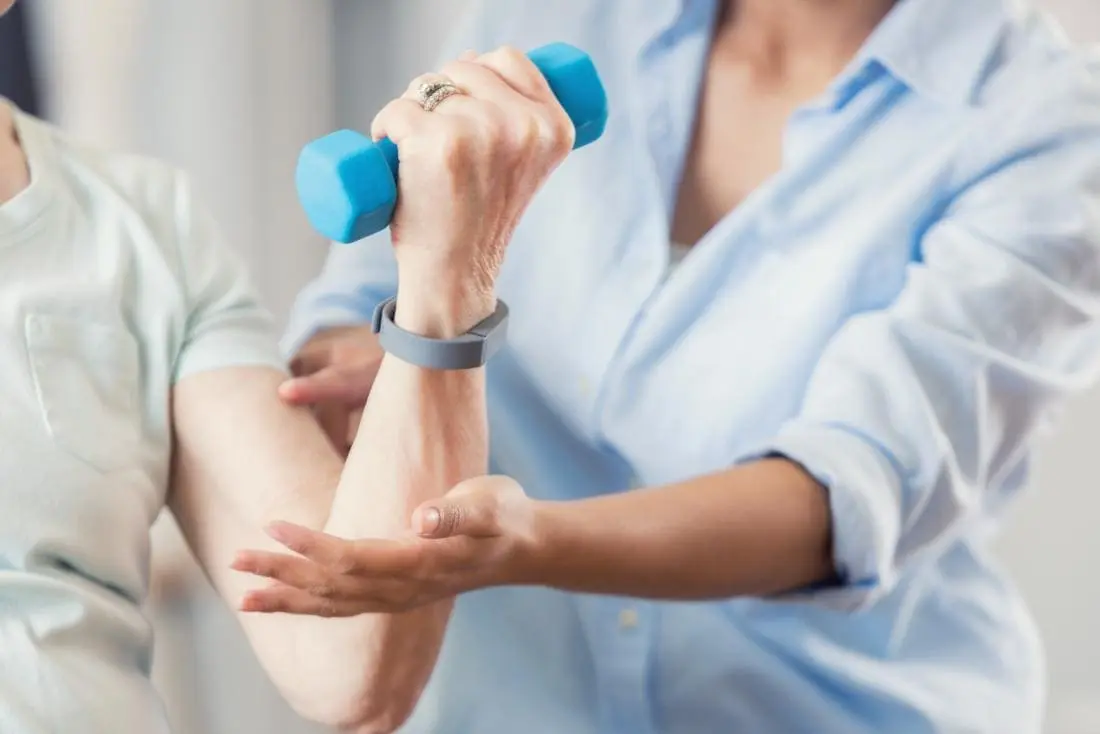Elbow pain is a common condition that can significantly affect daily activities and quality of life. Whether caused by overuse, injury, or underlying conditions such as tennis elbow or golfer’s elbow, managing and alleviating discomfort is crucial for maintaining functionality.
Exercise therapy plays a pivotal role in addressing elbow pain by promoting flexibility, strength, and stability. However, selecting the appropriate exercises tailored to individual needs and conditions is essential for effective rehabilitation and pain management.
In this guide, we explore some of the best exercises specifically designed to alleviate elbow pain, enhance range of motion, and strengthen the surrounding muscles.
Introduction:
Elbow pain might come from many different causes. Pain is most usually a result of trauma, repetitive motions or activities, or illnesses like arthritis. Tennis elbow and golfer’s elbow are the most common diagnoses, and they can last a long time or be very irritating.
The humerus, the arm bone, and the radius and ulna, the two forearm bones, make up the elbow joint. The radius joins the ulna immediately below the elbow joint, whereas the humerus joins the ulna at the elbow joint. The connective tissue capsule that covers the joint is stabilized by muscles, tendons, and ligaments.
While the forearm muscles regulate forearm rotation, the biceps and triceps muscles cross the joint and are in charge of bending and extending the elbow. The elbow joint is also lined with blood vessels and nerves, They provide nutrition and nerve system signals to the joint to keep it healthy.
Exercises for the elbows are important if you have difficulties or conditions related to elbow pain. If you suffer an injury to your elbow or upper limb, you may benefit from exercise and the help of a physiotherapist. They will help you strengthen your arm muscles and recover a normal range of motion.
The rehabilitation process for your elbow injury may include elbow exercises. If you’ve never exercised before, it’s a good idea to start lightly and increase over time. Exercises for the elbow help strengthen the surrounding muscles so that your elbow can move freely.
Pay attention to your level of pain during the workout, particularly at the beginning. It’s possible that these workouts first make your symptoms a little worse. However, with regular practice, they should get easier and help improve elbow mobility.
What is an elbow joint?
This hinge joint is composed of the ulna, radius, and humerus. Bone ends are cartilaginous. The flexible nature of this cartilage allows the joints to easily move against one another and experience damage. The ligaments that make up the joint capsule hold these bones together.
When moving the elbow, the following main muscles are used.
- Biceps brachii
- Triceps brachii
- Brachioradialis
- Pronator teres
- Anconeus
- Brachialis
Elbow joint pain causes:
There are several possible causes of elbow joint pain, so identifying the exact source of your suffering is important for receiving the right care. The most frequent reasons for elbow pain are inflammation and tension in soft tissues, such as your tendons and ligaments. Your elbow joint, as well as the surrounding muscles and soft tissues, may experience stiffness and pain due to specific medical problems, injuries, and scar tissue.
If you have cubital tunnel syndrome, the ulnar nerve, one of the primary nerves in your arm, gets compressed as it passes through the cubital tunnel and along the inside of your elbow. You might feel pain or numbness in your fingers, arms, and hands.
Arthritis is another condition that can cause elbow joint pain since it may cause inflammation and degeneration of the joints. Among the common types of arthritis that can affect the elbow joint are gout, osteoarthritis, and rheumatoid arthritis.
Bursitis is the result of swollen bursae. Bursitis is often caused by continuously performing the same movement, although it can also develop from an infection or an accident. Bursae are small fluid-filled sacs. Your tendons, muscles, and bones in your joints are all protected by them. They also facilitate the skin’s ability to cover the bone. pain, Swelling, and Stiffness are some effects of bursitis.
Conditions like tennis elbow and golfer’s elbow are examples of tendinopathy, also known as tendinosis, which suggests that your elbow’s surrounding tendons have been harmed by repeated use. Unlike their titles, injuries don’t only happen to tennis or golf players. You are more likely to develop them since those sports include certain arm movements. Tennis elbow often affects the outer elbow, whereas golfer’s elbow primarily affects the inner elbow.
Elbow joint pain can also be caused by injuries such as sprains, fractures, and dislocations. Sports-related activities, falls, and accidents can all cause these injuries. If you think you may have a fracture or dislocation, you should get medical help right away because these conditions may need to be treated right away.
The symptoms of an injured elbow:
- Inner elbow pain or burning
- Inability to fully extend the wrist toward the forearm
- Pain in the wrists, hands, and forearm
- Stiffness, tingling, and numbness
- Grasping your hand is difficult for you.
- Uncomfortable shaking hands with someone
- Having trouble bending the elbow
- Moving the elbow with difficulty
- Tenderness and swelling
What are the benefits of elbow exercises?
Exercises for the elbow joint include the following common advantages.
- Increases the strength and grip of the forearm.
- Improving your wrist joint’s range of motion.
- Increases stability by strengthening the muscles surrounding the hand joint.
- Exercise for the elbows can help avoid injuries and pain.
- Long-term flexibility can be increased over time by performing regular, safe elbow stretches.
- Exercise is beneficial to mental health in addition to its physical health benefits. Chronic pain management can have an adverse emotional effect. Exercise releases endorphins, which are organic painkillers and mood stimulants.
- Including exercise in your daily routine may improve your general well-being and help you better manage pain in your elbow joint.
Why physiotherapy is important for elbow pain:
Patients with elbow pain can better manage their condition with physiotherapy support because it improves strength, mobility, alignment, and function. It is possible to modify injured elbow exercises to the specific demands of each patient, regardless of age, condition, limitations, or kind of injury.
Elbow pain usually comes in two varieties: medial pain, which is felt inside the elbow, and lateral elbow pain, which is felt outside the elbow. These usually come on by holding, opening jars, climbing, and sports like tennis and golf.
Also, elbow pain usually resolves on its own and is not a significant condition. Your doctor may decide surgery is the best course of action in certain situations. Exercises from physical therapy are the first thing to try in other situations.
Your doctor will examine your elbow, forearm, wrist, and hands completely and ask you a series of questions before recommending a course of therapy to help you understand whether normal activities or a specific injury causes your problems. Sometimes, to figure out any possible problems your doctor may order more tests, such as MRIs, ultrasounds, X-rays, and other lab work.
Treatment options to promote healing could also include;
- Strengthening exercises: Forearm stretches done gently together with physical therapy are very beneficial.
- Medicines: Non-steroidal anti-inflammatory medications to minimize inflammation and lessen symptoms.
- Support braces: When activity is required, wearing a brace across your elbow and forearm offers additional support.
Precautions before beginning an exercise plan:
To ensure your safety and optimize the benefits, it’s important to think over a few precautions before beginning any fitness program. The best way to find out which exercises are best for your particular condition is to first speak with your doctor or a physical therapist.
It is important to pay attention to your body and not to force yourself above pain. While slight pain is common with exercise, severe or increasing pain may be a sign that you’re pushing yourself too much. Once you can tolerate more pain, Work slowly up to more tough routines by beginning with low-impact ones.
Maintaining correct technique and form is important for avoiding additional injuries. Consult a trained expert for advice if you’re not sure how to put out a workout properly. To better prepare your muscles and joints for the workout, warm up before any exercise.
Best Exercises for Elbow Pain:
Increased flexibility, reduced stiffness, and better range of motion in your elbow joint can all be achieved with stretches and range-of-motion exercises. Each day, you can perform these activities.
The best exercises for elbow pain that you can do are listed below.
Wrist extension
This exercise increased Strength and Mobility and improved grip strength and range of motion
- This exercise requires you to sit in a chair, hold a two-pound dumbbell straight in your hand, and place your elbow on the table.
- Bend your wrist away from your body to straighten it, with your palm toward the ground.
- Perform the exercise without any weight if you find it too difficult.
- Hold this position for a few seconds.
- Then return to your neutral position.
- Then relax.
- Repeat this exercise 5-10 times.
- Repeat the exercise with the other hand.
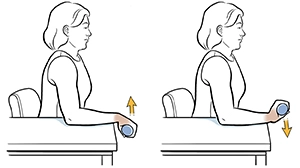
Isometric elbow flexion
This exercise strengthens the muscles surrounding your forearm’s radius and ulna bones as well as the biceps, which are placed in front of your upper arm.
- Use a chair and table for the isometric elbow flexion exercise.
- You must sit up straight in a chair and place your hands palm-side up under the table to perform this exercise.
- As if you were attempting to lift the table, raise your hands straight up.
- Hold this position for a few seconds.
- Put as much pressure on the area as you can without hurting it.
- Then return to your neutral position.
- Then relax.
- Repeat this exercise 5-10 times.
- Repeat the exercise with the other hand.
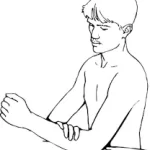
Wrist flexion
- For this exercise, you will sit in a chair and hold a 2-pound dumbbell upright in your hand with your elbow resting on the table.
- To bend your wrist, extend it inward toward your body while maintaining an upward palm position.
- Perform the exercise without any weight if you find it too difficult.
- Hold this position for a few seconds.
- Then return to your neutral position.
- Then relax.
- Repeat this exercise 5-10 times.
- Repeat the exercise with the other hand.
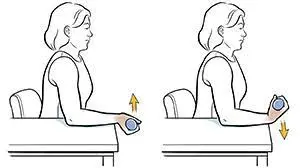
Elbow bend
- Take a few deep breaths and stand comfortably on the ground.
- Bend your arm slowly up until your hand touches your shoulder, and then lower your arm.
- Hold this position for a few seconds.
- Then return to your neutral position.
- Then relax.
- Repeat this exercise 5-10 times.
- Repeat the exercise with the other hand.
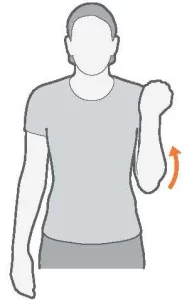
Wrist extensor stretch
- Straighten your left arm in front of your body and place your palm downward.
- Grab the left hand with your right, then gradually bend it down until your left forearm stretches.
- Hold this position for a few seconds.
- Then return to your neutral position.
- Then relax.
- Repeat this exercise 5-10 times.
- Repeat the exercise with the other hand.
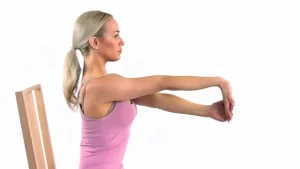
Wrist flexor stretch
- While standing, lift one arm in front of you, keeping your elbow straight and your palm toward the floor.
- To point your fingers toward the ceiling, use your other hand to gently bring the palm of your extended hand as close to you as feels comfortable.
- Allow your fingers to bend and release as you perform this stretch.
- Hold this position for a few seconds.
- Then return to your neutral position.
- Then relax.
- Repeat this exercise 5-10 times.
- Repeat the exercise with the other hand.
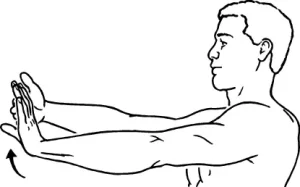
Triceps Extensions
- Start by lying on your back on a yoga mat with your feet planted securely on the floor.
- Using both hands, raise a dumbbell above your body while pointing your arms upward.
- Your palms should be facing up.
- Lower the dumbbell behind your head while maintaining the position of your upper arms and elbows.
- Your triceps muscles have to feel stretched.
- Hold this position for a few seconds.
- Then return to your neutral position.
- Then relax.
- Repeat this exercise 5-10 times.
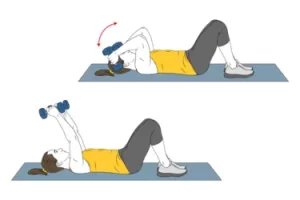
Biceps Curl
- Start by standing straight up and placing your feet hip-width apart.
- Maintain contraction of your abdominal muscles.
- With each hand, hold a single dumbbell.
- Allow your arms to be rested freely by your sides, with your palms facing forwards.
- Lift the weights until the dumbbells are close to your shoulders while maintaining a straight upper body and relaxed shoulders.
- Also, raise the dumbbells to your forehead or eyeballs for a complete range of motion.
- It’s important to always keep your elbows close to your upper body.
- Breathe out as you raise.
- Then return to your neutral position.
- Then relax.
- Repeat this exercise 5-10 times.
- Repeat the exercise with the other hand.
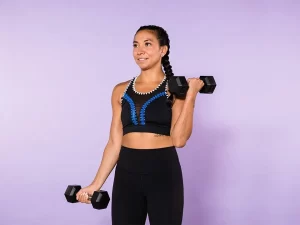
Towel Twist
- Grab a loosely rolled towel by length, holding it with one hand at either end.
- Don’t tighten your shoulders.
- Use your hands to twist the towel in different directions, just like you would to dry out water.
- Then return to your neutral position.
- Then relax.
- Turn the towel in the opposite direction and repeat five to ten times.
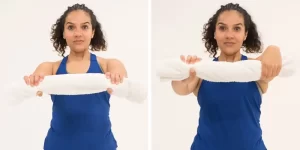
Ball squeeze
- Using a tennis ball, sock, or rolled-up towel, place it in your palm and make a fist with your fingers holding the ball or towel.
- Hold on to it tightly for a little time.
- Then return to your neutral position.
- Then relax.
- Repeat this exercise 5-10 times.
- Repeat the exercise with the other hand.
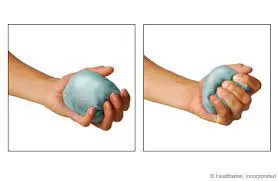
Supination with a dumbbell
- Sit in a chair with a 2-pound dumbbell placed upright in your hand and your elbow resting on your knee.
- Turn your palm up and rotate your arm outwards with the help of the dumbbell’s weight.
- Once your palm points downward, turn your hand back the other way.
- Try to maintain your elbow and upper arm fixed and keep your movement to your lower arm only.
- Then return to your neutral position.
- Then relax.
- Repeat this exercise 5-10 times.
- Repeat the exercise with the other hand.
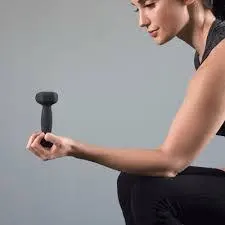
Forearm flexor wall stretch
- To start, move as close to a wall or cabinet corner.
- The elbow is positioned at a right angle, and your arm is at your side.
- Your forearm is pressed up against the wall with your hand over it.
- Stay relaxed with your thumb and fingers.
- Hold this position for a few seconds.
- Then return to your neutral position.
- Then relax.
- Repeat this exercise 5-10 times.
- Repeat the exercise with the other hand.
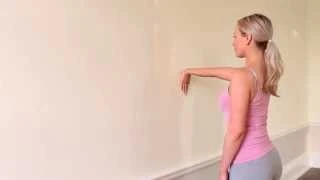
Wrist Turn
- Bend your elbow at a straight angle and extend your hand, palm up, with little or no weight on it.
- Turn your wrist gently so that your palm is facing down.
- Hold for a few seconds.
- Then return to your neutral position.
- Then relax.
- Repeat this exercise 5-10 times.
- Repeat the exercise with the other hand.
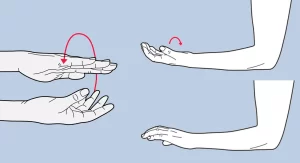
Tricep Dips
- Place two level benches parallel to each other and three to four feet apart.
- Sit on one bench with your back to the other and place your hands on the side of the bench.
- Using your hands to support your weight, raise your feet to the top of the other bench so that the rest of your body is hanging.
- When your forearms and upper arms are at a straight angle, softly bend your elbows toward the ground.
- Stay away from bending your shoulders below a 90-degree angle as this can cause tension.
- Then return to your neutral position.
- Then relax.
- Repeat this exercise 5-10 times.
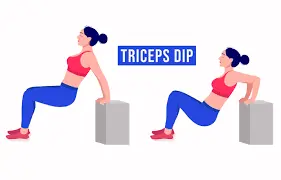
Supination & Pronation of the Forearm
- With your palm facing the side, start.
- Rotate the palm to face up slowly.
- To support your forearm, place your wrist on your thigh with your elbow bent at a 90-degree angle.
- Move your elbow to a slightly straight position.
- Keep your arm resting on your thigh.
- Gently bring the palm back to the beginning position before softly rotating it downward.
- Then relax.
- Repeat this exercise 5-10 times.
- Start light and work your way up to more repetitions until you reach your comfort level.
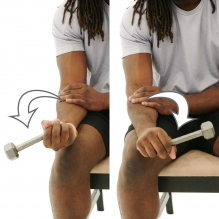
Open book stretch
- Lying on your side with your knees parallel to your hips, bend your legs, and extend your arms straight in front of you.
- Take a deep breath as you start to lift your upper arm above your head and extend it across your body.
- Imagine your arm opening a book in the same manner as you would.
- Your head should follow the direction of your extended arm, allowing your spine and chest to rotate in parallel.
- Exhale and let your arm move over your body, using your spine and chest to support it, until you feel the stretch around your ribs.
- Some people may experience that while their arm is flat on the other side of their body, but others may not experience it to this level.
- When it feels right for you, stop.
- Your spine and chest should have rotated so that your back is flat and your chest is toward the ceiling once you feel the stretch.
- Your hips should stay in place the entire time, but you should feel a little movement in them.
- Breathe deeply while maintaining this position, then release the breath as you turn your body back to the beginning position.
- Then relax.
- Perform five to ten repetitions of the exercise on each side of your body.
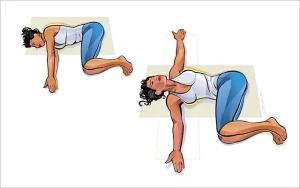
Finger Extension
- Wrap your fingers with an elastic band.
- Start by applying pressure to the tips of your fingers and thumbs.
- The band will tighten as you move your fingers away from your thumb.
- Spread your fingers apart and bring them close to one another.
- While you’re doing this, you should be able to feel the elastic somewhat stretch.
- Then return to your neutral position.
- Then relax.
- Repeat this exercise 5-10 times.
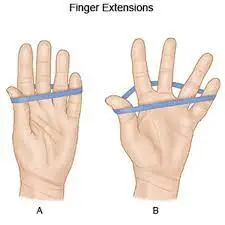
Overhead triceps stretch
- Raise your shoulders to your ears and then lower and extend them.
- With your middle finger lying on your spine and your right palm positioned in the middle of your back, raise your right arm to the ceiling and bend it at the elbow.
- Gently press your elbow down and toward the center with your left hand.
- Hold this stretch for a few seconds.
- Then return to your neutral position.
- Then relax.
- Repeat this exercise 5-10 times.
- Repeat the exercise with the other hand.
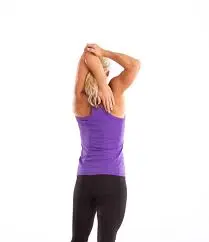
Physioball stretch
- Arms out to the sides when lying on a physioball should be relaxed.
- Your biceps and forearms will stretch more when you extend your wrists and straighten your elbows.
- Then return to your neutral position.
- Then relax.
- Repeat this exercise 5-10 times.
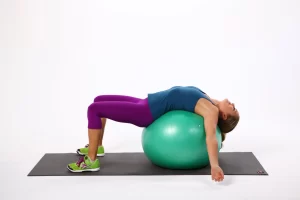
Biceps stretch
- First, take a comfortable position facing a wall or corner and place yourself about a few inches away.
- Raise your arm from the harmed side and try to contact the wall with your thumb side while holding your hand palm down.
- Try to maintain a straight arm.
- After that, rotate your body away from your raised arm until your muscles start to stretch.
- Hold this stretch for a few seconds.
- Then return to your neutral position.
- Then relax.
- Repeat this exercise 5-10 times.
- Repeat the exercise with the other hand.
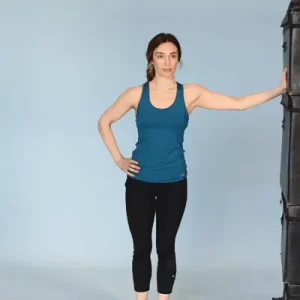
Band pull apart
- Begin by standing comfortably.
- Now cover your wrists in a small resistance band.
- Maintain a 90-degree angle with your elbows.
- Extend your wrists to fit the band.
- Hold this position for a few seconds.
- Then return to your neutral position.
- Then relax.
- Repeat this exercise 5-10 times.
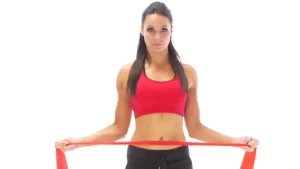
When to consult with a doctor
Although elbow joint pain can be effectively managed and relieved with exercises and other techniques, there are situations in which medical treatment may be required.
Getting medical attention is important if;
- Exercise and other conventional therapies either make your pain worse or have no effect at all.
- You feel acute pain that comes on suddenly, often after an injury.
- The area around your elbow joint feels warmed up, red, or swollen.
- Your arm feels weak, or you have trouble moving your elbow.
Your treating doctor will be able to figure out your condition, prescribe any required tests, and recommend the best course of treatment for you based on your particular needs.
Safety precautions to take when working out:
Exercise for elbow pain should only be started after speaking with a doctor or physical therapist. It’s important to perform safe, suitable exercises that take into consideration your particular situation.
- Stop exercising immediately if you feel any kind of pain.
- Stretch and warm up before working out.
- It is important to do all exercises per the protocol, which calls for stretches before and holds in between each exercise as well as the right amount of repetitions for each exercise.
- Avoid wearing tight clothing and dress comfortably so that your body may move freely when working out.
- It’s okay to stretch the tense muscle even if it pains. But you shouldn’t feel any strong or stabbing pain as you stretch.
- Take a rest in between workouts.
- Stay hydrated.
When did you not exercise?
- If your doctor has suggested that you rest.
- If an injury to one of your upper limbs recently happened.
- If this exercise hurts you while doing it.
- If you have a cracked arm bone.
Exercises for the Elbow You Should Avoid:
You should completely avoid engaging in any activity that gives you elbow or arm pain, either shooting or sharp.
Lifting and other repetitive motions: Any workout that requires you to move your elbows and wrists frequently may aggravate the problem. Try to stay away from completing too many repetitions when working on elbow exercises.
High-weight wrist exercises: As part of a treatment plan for elbow pain, physical therapists often recommend wrist exercises. But they only recommend using minimal or no weight for the exercises. Although barbell extensions and other high-intensity workouts are probably routine to you, you need to stay away from them while you heal.
Summary
It might be extremely difficult to carry out basic activities like lifting, gripping, or even extending your arm if you have elbow joint pain. The complex structure of the elbow joint is composed of muscles, tendons, ligaments, and cartilage. Pain and restricted movement may arise from damage or inflammation to any of these components.
Maintaining an active lifestyle is important, try to perform the right activities each day. To avoid your symptoms coming back, start slowly and gradually increase the amount of exercise you do. It might be difficult to live with elbow joint pain, but you can reduce pain and increase mobility with the correct exercises and techniques.
Conservative treatments including rest, activity caution, and pain management will help most elbow pains get better. More intensive treatment may be required for more severe pain or if the pain is caused by an underlying medical condition like arthritis. This can involve corticosteroid injections that reduce pain and inflammation, physical therapy to help strengthen the muscles surrounding the elbow, or surgery to replace or repair damaged tissue.
Also, remember to keep going even after your elbow feels better. Ask your physical therapist or physician any questions you may have about working out.
FAQ:
What is Elbow Pain?
Injuries to the elbows can result from trauma, overuse, and bad posture. Elbow pain is a common condition that may limit a person’s capacity to grasp, reach, lift, and load the arms.
How can elbow pain be managed at home?
The first thing to do after an injury to minimize swelling is to ice it. Pain can be reduced by taking over-the-counter (OTC) medications such as ibuprofen or other non-steroidal anti-inflammatory drugs (NSAIDs). It’s also advisable to wear an elbow brace, particularly when engaging in activities that cause pain.
Can you make your elbows stronger?
To strengthen the elbow joint, isometric elbow exercises involve improving a muscle without producing any noticeable movement. They work in physical therapy to help those who have had elbow surgery or who have suffered an elbow injury recover.
Does elbow pain improve with exercise?
Returning to movement and strength is important following an elbow problem. This will help with tissue repair and allow you to resume your activities. You might not see benefits right away at first, and it could take some time for you to return to your regular exercise schedule.
Can I exercise if I have elbow pain?
It shouldn’t make your current elbow pain worse in general to exercise. However, as the body adjusts to new movements, trying out new exercises may result in temporary muscular pain. This type of pain will go away soon, and the next morning after your workout, it shouldn’t be any worse.
Is it possible to exercise while wearing an elbow brace?
A tennis elbow brace or band puts pressure on the forearm muscles, relieving pressure from the wounded elbow tendon. Playing sports or working can both make use of the brace or strap.
Does yoga provide relief from elbow pain?
Athletes have discovered pain relief through mild stretching and simple yoga poses, which have helped them get back into shape and perform better on the tennis field.
How long does it take to recover from the elbow?
Following elbow surgery, recovery times might vary from six weeks to several months. Many factors will be considered, including your age, the restoration, the incision size, and the complexity of the procedure.
What is the elbow muscle used for?
In general, the muscles that control elbow movement are referred to as flexors or extensors. Helping to extend the arm outward are the extensor muscles on the inside of the arm. Bending the elbow will bring it closer to the body because the flexors are located at the back.
What is rehabilitation for the elbow?
A therapy approach called elbow rehabilitation has the goal to speed up healing following surgery or an injury to the elbow. One of the joints with the greatest range of motion in the body is the elbow.
What causes elbow pain?
A common cause of elbow pain is overuse or trauma. Repeated hand, wrist, or arm movements are necessary for many sports, hobbies, and occupations. Issues with bones, muscles, tendons, ligaments, or joints might give rise to elbow pain. Elbow pain is sometimes caused by arthritis.
What is the best way to sleep if I have elbow pain?
Take a nap on your back.
Many people spend entire nights resting on their sides. Because this position restricts blood supply to the damaged tendons, it may worsen the tennis elbow. Lying on your back reduces pressure on your arm and facilitates faster healing as you sleep.
What is the severity of elbow pain?
Even while elbow pain is frequently treatable at home and will get better with time, sometimes a visit to the doctor is necessary. If you have a clear elbow deformity or a bone sticking out of the skin, you ought to go to emergency care straight once.
Does heat help with elbow pain?
Heat promotes blood flow to a particular area of the body, which helps reduce pain, promote the healing of injured tissue, and lessen stiffness. If your elbow is swollen or you have recently damaged it, avoid applying heat to it since this can worsen the condition. Ice can lessen swelling by reducing blood flow to a particular body area.
Can ice help with elbow pain?
Ice therapy has many benefits when treating the elbow. Ice can reduce pain and inflammation while improving function and range of motion. By increasing blood flow to the injured area, ice can also help in the healing process. The capacity of ice to lower inflammation is one of its most significant advantages.
When I have elbow pain, which workouts should I avoid?
You should keep away from doing certain exercises until your elbow heals since they could worsen the pain. They include activities that call for you to maintain your arms straight and your elbows extended, heavy lifting, and any repeated arm or wrist movement.
Does elbow pain require surgery?
If, after more than six to twelve months of joint rest and rehabilitation, you still experience elbow pain, your doctor may suggest surgery. Elbow pain prevents you from performing your usual tasks or working.
What type of workout works the elbows the best?
Wrist extension
Wrist flexor stretch
Elbow bend
Supination & Pronation of the Forearm
Biceps stretch
What happens if you don’t get treatment for elbow pain?
If you continue the repetitive activity that caused the condition, the elbow pain may become chronic and have for months or even years if treatment is not received.
References:
- March 17, 2023; Cadman, B. Tennis elbow exercises: eight. Exercises: https://www.medicalnewstoday.com/articles/322746 Citation within the text: (Cadman, 2023)
- P. on December 5, 2023. Elbow arthritis exercises to do at home. Hand to Shoulder Center in Philadelphia. What exercises can be beneficial for people with elbow arthritis? https://www.hand2shouldercenter.com/
In-text Reference: (2023) - Movva, V. (November 8, 2023). These are 5 Efficient Exercises for Elbow Joint Pain Relief and Increased Mobility. India’s RegenOrthoSport. Exercises for elbow joint pain that are effective in relieving discomfort and enhancing mobility can be found at https://regenorthosport.in/blog/
Reference inside text: (Movva, 2023) - Elbow: Posture, Exercises, and Stretching | Work-Fit (n.d.). Elbow at https://www.work-fit.com/live-fit
In-text Citation: (Work-Fit, n.d.) Elbow – Stretching, Exercises, & Posture - P. August 12, 2022. The causes, physiotherapy treatments, and exercises of elbow pain. What causes elbow pain and what can be done to treat it with physiotherapy and exercises?
In-text Reference: (2022) - S. Physio (n.d.). Surrey Physio’s Top 5 Elbow Pain Exercises. Physio Surrey. https://www.surreyphysio.co.uk/top-5/top-5-elbow-pain-exercises/
Reference within the text: Physio, n.d. - Freutel, N. (February 2, 2023). Five Activities to Rehab Your Tennis Elbow. Healthline. The exercises listed on https://www.healthline.com/health/fitness-exercise/tennis-elbow-rehab Citation inside the text: (Freutel, 2023)
- M. L. Ireland (1995, May). BASKETBALL ELBOW PAIN, RIGHT ELBOW. Sports & Exercise Medicine & Science, 27(Supplement), S61. 10.1249/00005768-199505001-00342 is the DOI link.
Reference within the text: Ireland (1995) - Image 1, Extension of Wrist (Strength). (As of now). Saint Luke’s Medical Center. Strengthening of the wrist elongation at Saint Luke’s Church, Kansas (Wrist Extension (Strength), n.d.) is the in-text citation.
- Image 2, Isometric flexion. (n.d.). Occupational therapy (https://iris.hattiesburgclinic.com/patadv/exkit/0060000003elb04_English.html).Reference within the text: Flexion (Isometric), n.d.
- Image 3, Wrist Extension (Power). (n.d.). Saint Luke’s Medical Center. Wrist Flexion Strength: https://www.saintlukeskc.org/health-library
Reference within the text: (Wrist Flexion (Strength), n.d.) - Image 4, Tennis elbow exercise recommendations. 2017 May 18. The Society of Chartered Physiotherapists. Tennis elbow rehabilitation exercises can be found at https://www.csp.org.uk/public-patient.
Reference within the text: “Tennis Elbow Exercise Advice, 2017” - Image 5, R. M. P. (Apr. 2, 2014). To extend the forearm flexor muscles, perform a wrist extension stretch. YouTube. Watch this video at https://www.youtube.com/?v=cOYA0cTIwzM
The 2014 In-Text Citation - Image 6, Complete Reference: Wrist Flexor Extension. (n.d.). The URL for this page is https://iris.hattiesburgclinic.com/patadv/exkit/Orthopedic/English/0290000452hand013m French.html.
Reference within the text: (Wrist Flexor Stretch, n.d.) - Image 7, Exercise routines – SUPINE DUMBBELL TRICEPS EXTENSION (n.d.). https://www.workoutsprograms.com/exercises/triceps-extension-with-a-supine dumbbell
In-text Citation: (Exercises Routines – Supine Dumbbell Tribes Extension, n.d.) - Image 8, The source of this information is Schultz, R. (2021, November 2), “How To Do A Biceps Curl Like A Total Beast,” Women’s Health, https://www.womenshealthmag.com/fitness/a26438159/bicep-curls/.
- Image 9, tennis elbow exercises, towel twists, and Andries Lodder, a biokineticist | Bio4Me. (2019, October 7). Tennis elbow treatment tips: https://www.bio4me.co.za/2019/10/tennis-elbow-exercises; bio kineticist Andries Lodder
In-text citation: (Biokineticist Andries Lodder | Bio4Me, 2019) towel-twist-tennis-elbow workouts - Image 10, Tennis elbow strengthening exercises. (n.d.). Conditional pages in the MyHealth.Alberta.ca/Health/pages.aspx?hwid=zm2473 Internal Reference: (Tennis Elbow Strengthening Exercises, n.d.)
- Image 11, To view, sign up, or log in. (As of now). Photos/a.668550939981264/1125015181001502/?type=3 can be found at https://www.facebook.com/WFATAOfficial
In-Text Reference: (Sign up or log in to View, n.d.) - Image 12, R. M. P. (Apr. 2, 2014). How to stretch the wall of your forearm flexors. YouTube. YouTube: https://www.youtube.com/watch?v=Cj9b3nI1EHU
The 2014 In-Text Citation - Image 13, 7 Physical Therapy Exercises to Help Your Injured Elbow. September 24, 2022. Hand Center in Fort Worth. Physical therapy exercises for injured elbows can be found at https://fortworthhandcenter.com/orthopedic
In-text Citation: (7 Physical Therapy Exercises to Help Your Injured Elbow, 2022). - Image 14, Advantages, hints, methods, and safety measures for tricep dips. January 28, 2021. dips training on myUpchar, https://www.myupchar.com/en/fitness
Tricep Dips: Advantages, Advice, Method, Safety Measures, 2021 - Image 15, Create a Free HEP with HEP2go. (As of now). This link will take you to the exercise editor on Hep2Go.com. In-text Citation: (HEP2go – Create a Free HEP )
- Image 16, What Is The Best Way To Rotationally Exercise Without Injuries? November 3, 2021. Visit Experience Life at https://experiencelife.lifetime.life/article/safe-rotational-exercises-expert-answers.
Internal Reference: (How Do I Perform Rotational Exercises Without Injuring Myself? 2021). - Image 17, Dhameliya, N. ( June 8, 2022). Exercise with your fingers: health benefits, how to do it? Samarpan Physical Therapy. Exercises for the Fingers at Samarpan Physiotherapy Clinic. https://samarpanphysioclinic.com/
Reference inside text: (Dhameliya, 2022) - Image 18, Lohre, J. March 31, 2023. Stretching the Triceps Above. Overhead-tricep-stretch by Julie Lohre. https://julielohre.com/
Reference inside text: (Lohre, 2023) - Image 19, using a gym ball for stretching. (n.d.). products. aspx?cname=stretching+with+gym+ball&cid=49&pr=59.99&ll=unimedcomsg from https://gco.pdoqs.top/products.aspx
In-text Citation: (Gym Ball Stretching, n.d.) - Image 20, E. Cronkleton (June 24, 2019). Exercises: 6 Bicep Stretches You Should Include. The website Healthline provides information about bicep stretches.
Reference inside text: (Cronkleton, 2019) - Image 21, W. Shoulder exercise – External Rotation Retraction, YouTube, September 14, 2011. In-text citation: (2011, )

